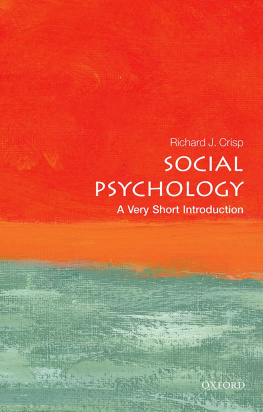Attitudes and Persuasion: Classic and Contemporary Approaches
Attitudes and Persuasion: Classic and Contemporary Approaches
Richard E. Petty
John T. Cacioppo
Ohio State University
First published 1996 by Westview Press
Published 2018 by Routledge
711 Third Avenue, New York, NY 10017, USA
2 Park Square, Milton Park, Abingdon, Oxon OX14 4RN
Routledge is an imprint of the Taylor & Francis Group, an informa business
Copyright 1981, 1996 by Taylor & Francis
All rights reserved. No part of this book may be reprinted or reproduced or utilised in any form or by any electronic, mechanical, or other means, now known or hereafter invented, including photocopying and recording, or in any information storage or retrieval system, without permission in writing from the publishers.
Notice:
Product or corporate names may be trademarks or registered trademarks, and are used only for identification and explanation without intent to infringe.
A CIP catalog record for this book is available from the Library of Congress.
ISBN 13: 978-0-8133-3005-1 (pbk)
Dedicated to our families: The Pettys
(Edmund, Jo Ann, Arlene, Jane, Tom, and Lynn) and
The Cacioppos
(Cyrus, Mary Katherine, Susan, Nick, Bob, and Barbara)
Contents
The present book provides a needed survey of a truly remarkable number of different theoretical approaches to the related phenomena of attitude and belief change. Aside from the obvious advantage of summarizing the relevant literature within one source, the book also serves the function of calling our attention to neglected theories, such as variable perspective theory, which are far more deserving of attention than the present level of research activity, or inactivity, would indicate. This is a competent and important book; a book deserving of attention by both beginning and advanced students of attitude and belief change.
In view of Richard Petty and John Cacioppos impressive and important research within the framework of the cognitive-responses approach to persuasion it is perhaps not surprising that they would write a discerning book. In view of the recent paucity of interest in attitude change, however, what is perhaps more surprising is that there appears to be an increasing receptivity to research and theory in this general area. Interest in attitude change appears to be resurgent. Why is this? Without any claim to certainty, it is possible to point to a number of possible causes. First, as Petty and Cacioppo point out, past skepticism regarding the effect of attitude on behavior has been replaced by the realization that, under some circumstances, at least, attitudes do affect behavior. Second, it may well be that renewed interest in attitude change is fostered to some extent by a more general interest in cognitive processes both within social psychology and other subfields or disciplines. Third, skepticism regarding the external validity of laboratory studies of attitude change has been mitigated by the realization that the large number of field studies done with subjects who do not know that they are subjects has not greatly altered our conclusions. It is increasingly recognized that while the demand-characteristics problem, for example, may arise in some circumstances and certainly does need to be guarded against, the problem has been vastly overestimated. Generalized cynicism regarding laboratory findings simply is not justified. Fourth and finally, attitude change as a field may be benefitting from the decline of anti-establishment attitudes. During the sixties the field of attitude change clearly was part of the establishment in social psychology, and also, because of its association with commercial advertising, had an obvious relation with the business establishment.
For those of us who have persisted in maintaining a positive attitude toward the field of attitude change, the current renewal of interest is understandably welcome. In my judgment the present book will make an important contribution to that renewal.
Chester A. Insko
University of North Carolina
The study of attitudes and persuasion cuts across many academic disciplines and is of interest also because of its relevance to and pervasiveness in our daily lives. Our goal was to write a book that would not only provide students with an up-to-date background in the psychological theory and research on attitude change processes, but one that would also give an appreciation for how basic research can yield useful insights into the types of social influence situations that occur frequently in our day-to-day living.
Over the last forty years, a large number of theories have developed to explain how and why peoples attitudes change. We have grouped these theories into seven major approaches, and each approach is presented and evaluated in a separate chapter in this text. We believe that each of the approaches contributes in an important way to a complete understanding of the persuasion process. Our subtitle characterizing the seven approaches as classic and contemporary is not meant to imply that some approaches are classic whereas others are contemporary, but that all of the approaches we discuss are classic and contemporary. The approaches are all contemporary in that all have their current advocates. They are classic in that we believe that they all have madeand will continue to makea vital contribution to explaining certain attitudinal phenomena. None of the approaches, however, is capable of accounting for the full range of attitudinal phenomena that exists. In the concluding chapter of this book, we present an integrative framework for thinking about the persuasion process that synthesizes the various approaches into two distinct routes to persuasion. This framework provides a method for organizing and understanding the basic commonalities and differences among the seven approaches.
We have attempted to write this book at a level that will be understandable to undergraduates who have had an introductory psychology course and perhaps a course in social psychology, but the book contains material that should be informative to graduate students as well. Any material that would be of interest primarily to graduate students, however, has been placed in footnotes. Courses for which the book would be most appropriate are taught in psychology, sociology, and communication departments, usually under the titles Attitude Change, Attitude Theory, Persuasive Communication, and so forth. In addition, some instructors might find the book to be a useful supplement in such courses as the Psychology of Advertising, Marketing Research, Consumer Behavior, and Public Opinion, which are usually taught in journalism, marketing, and political science departments.
On a more personal level, we note that writing this book led to more of just about everything than we initially expectedmore time, more disagreements, but also more rewards, more fun, more dining out, and a greater appreciation for the advances made in understanding the complex process by which one person comes to influence another.
R. E. Petty
J. T. Cacioppo
There are many people to thank in preparing this text. First, we would like to thank John Harvey, a friend and colleague at Vanderbilt University who first suggested to us the idea of writing this book. Four other colleagues (Hal Sigall, University of Maryland; leek Ajzen, University of Massachusetts; David R. Shaffer, University of Georgia; and Mark P. Zanna, University of Waterloo) provided detailed comments on the first draft of the text that were thoughtfully prepared and most helpful. Chet Insko (University of North Carolina) graciously consented to our request to write the foreword. We also acknowledge a debt to the earlier works on attitude change from which we learned so much (especially Hovland, Janis, & Kelley, 1953; Insko, 1967; Kiesler, Collins, & Miller, 1969; and McGuire, 1969b). We are grateful to our advisors in graduate school, Tim Brock and Tony Greenwald of Ohio State University, whose enthusiasm about scientific inquiry was contagious and who gave us the freedom and guidance to pursue those research topics that we found most appealing. Our editors at the Wm. C. Brown Co. (Susan Soley and Marian Warner), our colleagues at the universities at which we served (Missouri, Iowa, and Notre Dame), our students (especially Martin Heesacker and Charlotte Lowell), and our secretaries (Lenore Hizer and Sue Staub) also made valuable contributions to the text. Much of our own research reported in this text was supported by grants from the National Science Foundation (BNS 7818667, 7913753, 8023589), the National Institute of Mental Health (31798-01, BRSG-G603), and our universities (Research Council summer grants, Old Gold Fellowship, Faculty Scholar Award No. A240). Finally, and most importantly, we are grateful for Lynn and Barbara who fill our lives with joy and love.










